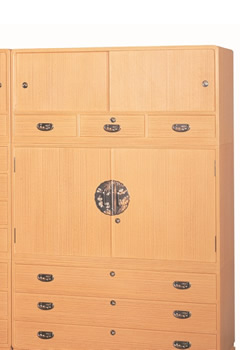KASUKABE Kiri Tansu (Paulownia Chests)

At the beginning of the Edo era (1600-1868), craftsmen building the Toshogu Shrine in Nikko took up residence in the town of Kasukabe along the old Nikko post road. It is said that these craftsmen started the craft of Kasukabe paulownia chests by making cabinets and other small items using paulownia wood from the surrounding area.
A document from the middle of the Edo era provides insight into when and where production in the area began, mentioning ten paulownia chest craftsmen. Further such evidence is a paulownia chest with the date 1772 inscribed on the back that still exists today.
From as far back as the Edo era, these chests have been characterized by their linear design and quiet, simple appearance with minimal decoration, fostered by a warrior culture that respected strength and undecorated elegance. Traditional chests, chest of drawers and wardrobes are still being made to the same specifications today.
Feature
From as far back as the Edo era, Kasukabe Kiri Tansu paulownia chests have been characterized by their linear design and quiet, simple appearance with minimal decoration, fostered by a warrior culture that respected strength and undecorated elegance.
How to make
The method of producing the chests involves preparing the wood, assembling the body and other parts, coloring and setting the metal finishings. No shortcut is taken when preparing the boards. Expressing the full beauty of the paulownia wood is the very soul of Kiri Tansu chests. After being allowed to dry naturally, the boards are assembled using a variety of traditional joinery methods to produce a robust and sturdy product.

